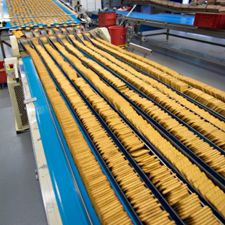
Combustible dust explosions are a high risk in many food industries, especially in grain milling and processing, which creates highly flammable dusts. Whether you're installing a new dust collection system or are working to upgrade or modernize your existing one, the following requirements will help you to make the choices that will allow you to comply with OSHA and NFPA regulations for dust control and management.
For the most part, this document refers to standards listed in NFPA 61: Standard for the Prevention of Fires and Dust Explosions in Agriculture and Food Processing. This standard covers all facilities working with bulk grains, oilseeds, seeds, legumes, sugar, flour, spces, feed, and other related materials.
The standard process for implementing a dust collection system include:
1. establish safety goals;
2. evaluate all aspects of the facility with regard to safety
3. identify potential hazards
4. define appropriate hazard scenarios
5. establish performance objectives and criteria;
6. select calculation methods
7. develop a proposed solution
8. assess the solution
9. obtain approval.
For the most part, these processes should be handled by experts, whether contracted or in-house. In short, this process is to identify what combustible dusts you have, identify how much of them you have, define what can happen if dusts are left unchecked, create solutions and methods to calculate the level of dust, and then work out a dust collection and control solution.
OSHA and NFPA regulations require that you have a dust collection system and an explosion suppression system.
Dust Collection System
The dust collection system should be comprised of a dust collector, local dust collection such as exhaust hoods or conveyors, air purification, fans and motors to move dust, filters, and a suitable system of ducts. Depending on your industry, you may be able to work with a local dust collection system, a vacuum system, or a combination of both.
Local Dust Collection – You are required to install exhaust hoods or conveyors at every dust creation point including but not limited to mill areas, over conveyors, at leg boot sections, belt loaders, belt discharge areas, trippers, turn heads, all unfiltered vents, all non-dust-tight machinery (such as cleaners, scalpers, etc). You should prevent dust from escaping into the surrounding environment, therefore, if the conveyor or exhaust hood is not sufficient, the area should be made dust-proof to prevent the dust from escaping.
Enclosures – Some machines must be enclosed in order to control dust. This typically includes packaging and weighing systems, scale hoppers, upper and lower bins, and other similar equipment.
Fans and Blowers – Fans and blowers should be spark resistant Type A or B.
Dust Collectors – Dust collectors should be located outside of the building whenever possible in order to reduce the chances of an explosion unless equipped with an explosion suppression system. The dust collection system should be designed to start up before machinery is operated and the machinery should be designed to automatically shut off if the dust collection system fails or ceases operation.
Note: In some cases, you may be required to install a separate dust collection system per department. For example, each department in starch manufacturing must use an individual dust collection system.
Filters – Dust collection systems may use any type of filter, but the filter should be installed with a monitor to prevent clogs, and potentially dangerous combustible dust buildup. Vertically mounted dust collection filters are also sutable for explosion protection, because they ensure that dust is not trapped in the filter, where it is still combustible. You may recycle air back into the area, providing you are using return filtration with a minimum efficiency of 99.9% at 10 microns.
Dust Bins and Tanks – Dust bins and tanks should be dust tight, constructed of non-combustible materials, and should be located outside of the building. They should use upstream conveyance, and should feature rotary valves or choke seals to prevent explosion propagation.
Piping, Ducts, Valves, and Blowers - All pipes, valves, and blowers should conform with the following standards:
- Pipes and ducts should be supported to carry the weight and pressure of dust and air
- Ducts should be airtight and dust tight
- Easy to disassemble for cleaning and maintenance
- Sealable with multi-direction valves to prevent explosion propagation
Housekeeping
It is crucial to maintain regular housekeeping in order to comply with OSHA and NFPA regulations. This means creating a schedule based on local dust production, creating cleaning strategies, and ensuring that dust is removed from hard to reach places. Compressed air may be used to control dust on walls and ceilings, but only after all machinery is turned off and all ignition sources are removed.
Explosion Protection
The explosion suppression system is designed to protect employees and workers in case of an explosion. This system is mandatory in most workplaces. It should include passive and active explosion suppression.
Passive Explosion Prevention – Passive explosion prevention is designed to minimize damage in case of a combustible dust explosion. It can contain:
- Explosion venting
- Flameless venting
- Passive float valve
- Backdraft damper
- Flame front diverts
Active Explosion Protection – Active explosion protection is designed to react in case of an explosion to suppress flames or explosions.
- Chemical isolation
- Chemical flame suppression
- Fast acting valve
- High speed abort valve
You may also require spark arrestors near spark and heat sources, drop out boxes around spark sources, and fire sprinkler systems.
Any dust collection system requires a complex mix of equipment to ensure that you can safely collect, transfer, separate, and store dust. This means that you will have to have a system designed to your specific needs, to handle your dust output, storage requirements, and workplace hazards.
Read More:

 Contact Us For a Consultation
Contact Us For a Consultation